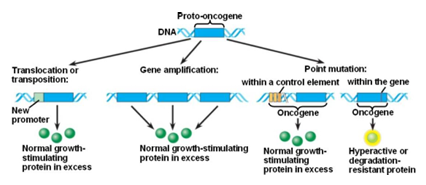Chapter 6 - Reproduction at the Cellular Level
1/112
There's no tags or description
Looks like no tags are added yet.
Name | Mastery | Learn | Test | Matching | Spaced |
|---|
No study sessions yet.
113 Terms
In sexually reproducing organisms, including humans, what is the starting point of life?
Life begins as a fertilized egg, or zygote
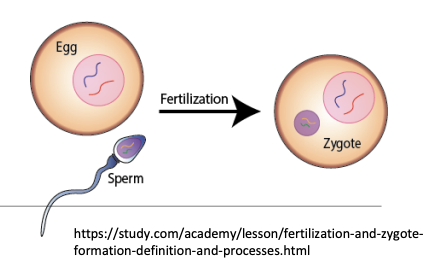
How does a zygote become a complex, multicellular human?
Through trillions of cell divisions that occur in a controlled manner
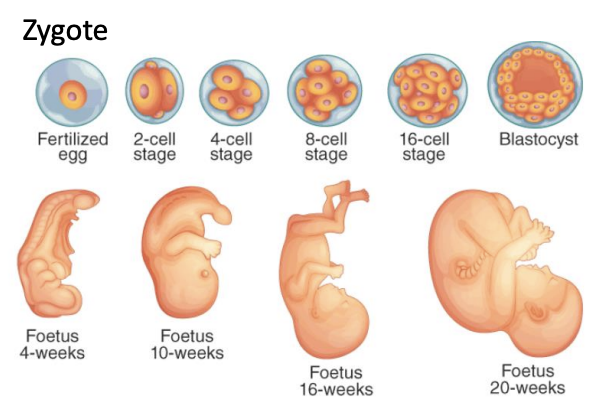
What is the relationship between the original single cell (zygote) and the other cells in the human body?
The original single cell is the ancestor of every other cell in the body
Once a human is fully grown, why does cell production remain necessary?
To repair or regenerate tissues
What are examples of cells that are constantly produced in the human body?
New blood cells and new skin cells
What do multicellular organisms use cell division for?
Growth, maintenance, and repair of cells and tissues
What do single-celled organisms, such as bacteria, use cell division for?
Cell division is their method of reproduction
What provides the foundation for the continuity of life from one cell to another?
The reproduction of cells by way of the cell cycle
What is the cell cycle?
Orderly sequence of events in the life of a cell from the division of a single parent cell to produce two new daughter cells, to the subsequent division of those daughter cells
What is the genome?
The complete set of genetic information in a cell
What are chromosomes?
Condensed DNA associated with proteins
What do chromosomes have to do with cell division?
In the cell cycle, chromosomes must first duplicate (by DNA replication) and then move into the two daughter cells
What is characteristic about the number of chromosomes in eukaryotes?
Each species of eukaryote has a characteristic number of chromosomes in the nuclei of its cells
How many chromosomes do human somatic (body) cells contain?
46 chromosomes
What is a somatic cell?
Body cell, non-sex cell, contains 46 chromosomes
What does a karyotype show?
Shows number and appearance of chromosomes in the nucleus of a somatic cell
What are homologous chromosomes?
Matching pairs of chromosomes (nearly identical) that carry the same genes controlling the same inherited characteristics
Can homologous chromosomes have different versions of the same gene?
Yes, two homologous chromosomes may have different versions of the same gene
How many homologous chromosome pairs do humans have, and where do they come from?
23 homologous pairs (46 chromosomes total): one chromosome from mom and one from dad
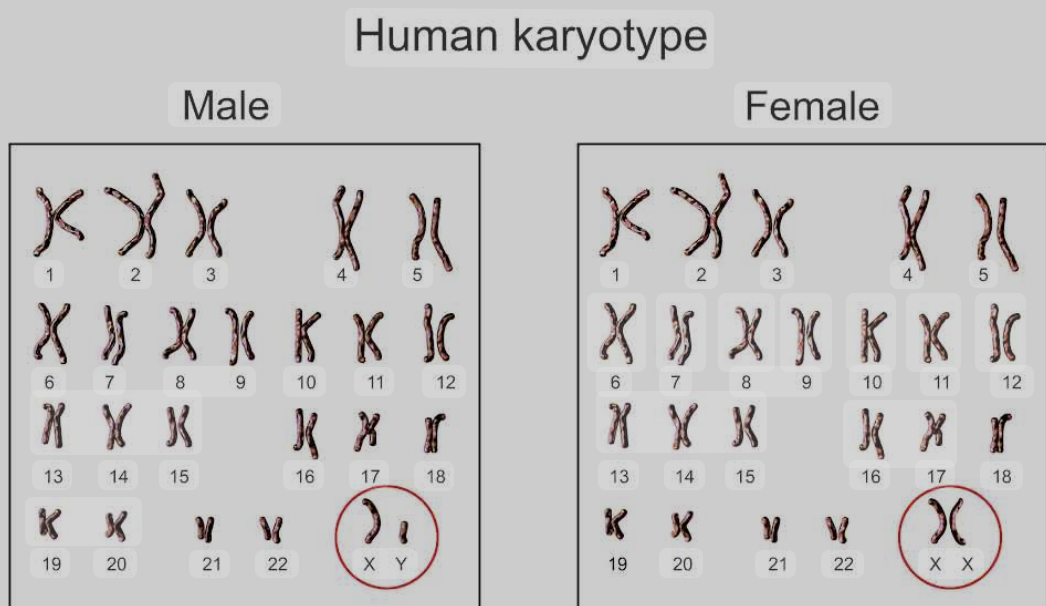
What does diploid mean?
A somatic cell that contains pairs (two complete sets) of chromosomes (one set inherited from each parent)
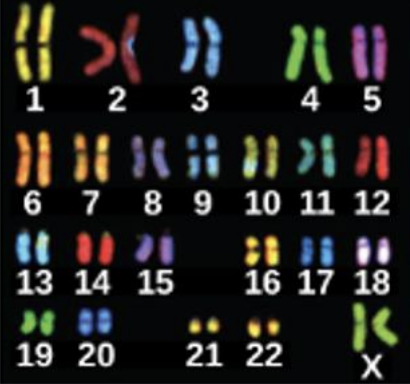
What is the human diploid number of chromosomes?
Human’s diploid number of chromosomes is 46 (2n)
What does haploid mean?
Gametes (sex cells) contain single chromosome set
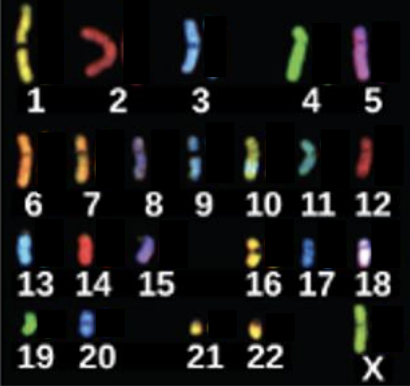
What is the human haploid number of chromosomes?
Human’s haploid number of chromosomes is 23 (n)
How do the terms diploid and haploid differ from each other?
Diploid refers to cells that contain pairs of chromosomes
In humans, somatic cells are diploid (2n=46)
Haploid refers to cells with a single set of chromosomes
In humans, gametes are haploid (n = 23).
What are sex chromosomes?
One set of chromosomes that determines person’s sex
What sex chromosome combinations correspond to biological male and female in humans?
XY = male
XX = female
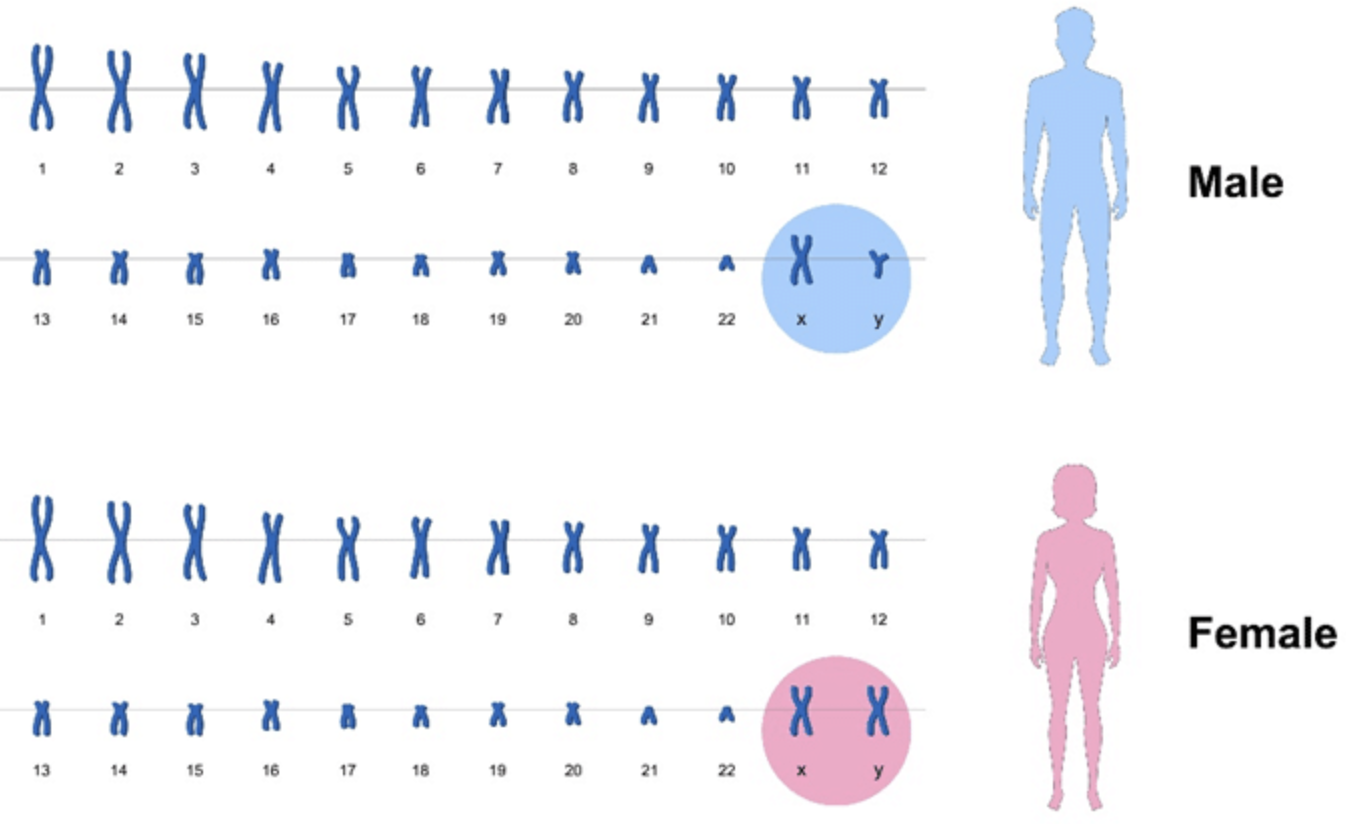
What are autosomes?
Non-sex chromosomes, 22 sets of chromosomes, found in both males and females
Humans have 22 pairs of autosomes and one pair of sex chromosomes (XX or XY)
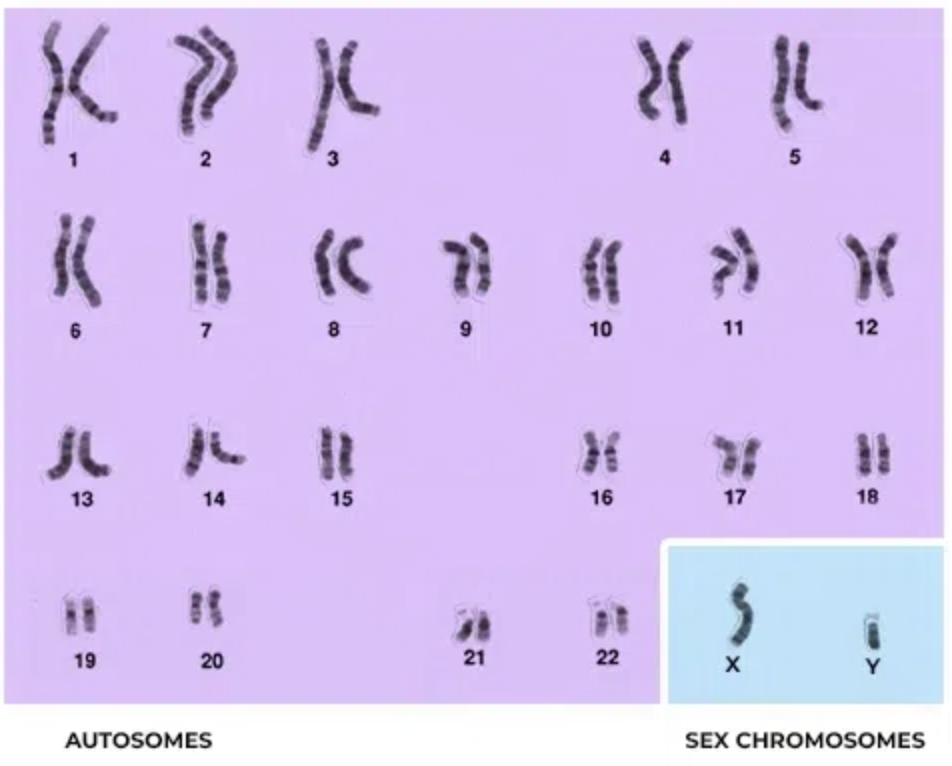
What is the difference between autosomes and sex chromosomes?
Sex chromosomes are one set of chromosomes that determines a person's sex (XY is male, XX is female). Autosomes are non-sex chromosomes found in both males and females, humans have 22 sets of autosomes.
What are homologous chromosomes?
Chromosomes that are the same length and have specific nucleotide segments called genes located in exactly the same position, or locus
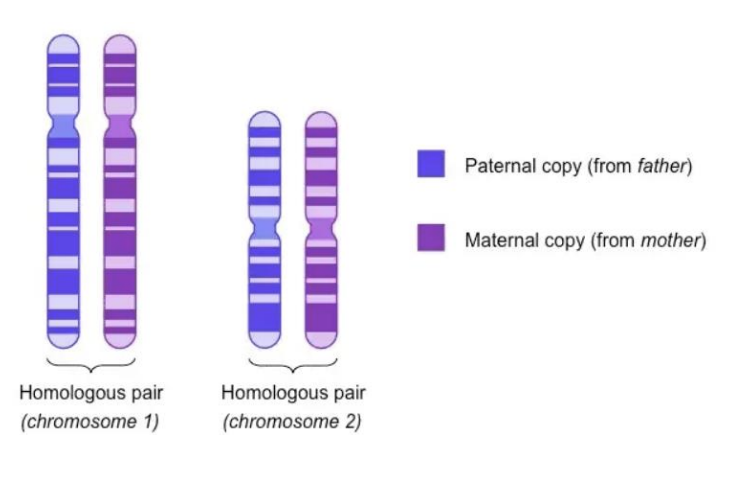
What is a gene?
A specific nucleotide sequence that determines specific characteristics by coding for specific proteins
What are traits? Provide an example.
Traits are the different forms of a characteristic
Ex) The shape of earlobes is a characteristic with traits of free or attached
Where does each copy of a homologous chromosome pair come from?
Each copy of the homologous pair of chromosomes originates from a different parent
Are the genes on homologous chromosomes identical?
The copies of each of the genes may not be identical
What causes variation of individuals within a species?
The specific combination of the genes inherited from both parents
Minor variations in traits such as those for blood type, eye color, and height contribute to the natural variation found within a species
Which chromosomes are the single exception to homologous chromosomes?
The sex chromosomes, X and Y
Why are X and Y chromosomes not fully homologous?
Other than a small amount of homology needed to produce gametes, the genes on the X and Y chromosomes are not the same
What do chromosomes have to do with cell division?
Chromosomes have to:
Duplicate (DNA Replication)
Divide equally between 2 daughter cells (lots of chromosome movement during cell division)
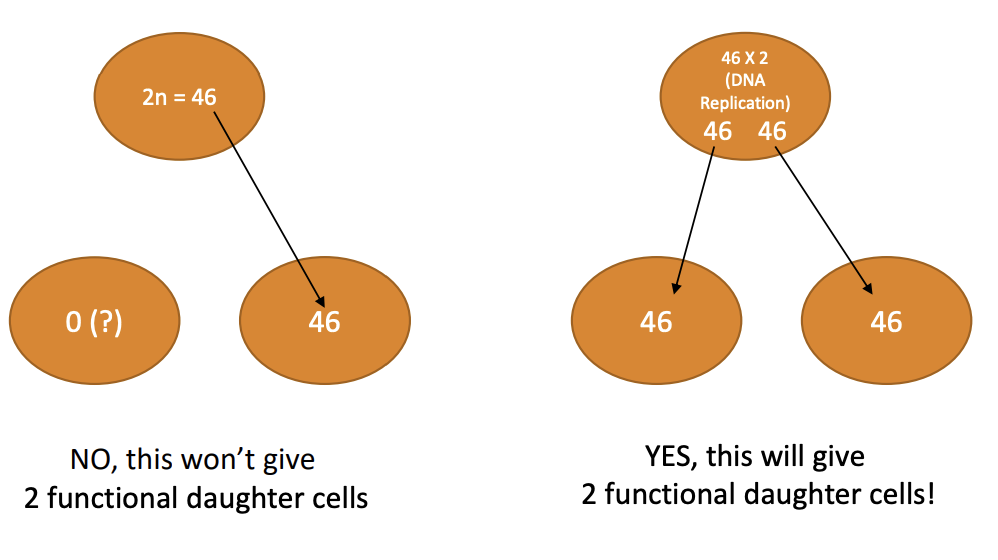
What happens to the cells on the path to division?
They proceed through a series of precisely timed and carefully regulated stages of growth, DNA replication, and division that produce two genetically identical cells
What is the order of events that occur in the cell cycle and which stage is the longest?
The cell cycle: Interphase (G1, S, G2), Mitosis (PPMAT), and Cytokinesis. The longest stage is Interphase as the cell is preparing the divide.
What occurs during interphase?
The cell grows and DNA is replicated
The cell spends most of its time in interphase
What occurs during the mitotic phase?
The replicated DNA and cytoplasmic contents are separated and the cell divides
What is interphase?
The phase in which the cell undergoes normal processes while also preparing for cell division:
Nucleus intact
Chromosomes loosely packed (decondensed)
Centrosomes are present
Cell growth
DNA is duplicating
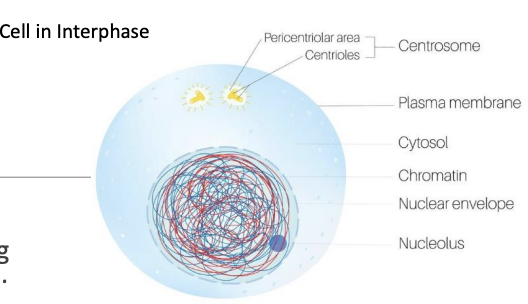
What are the three stages of interphase?
G1, S, and G2 phases
What happens during the G1 phase (first gap) of interphase?
The cell grows and prepares for DNA replication. It is highly active biochemically, accumulating:
Building blocks of chromosomal DNA and associated proteins
Energy reserves to replicate each chromosome in the nucleus
What happens during the S phase (synthesis) of interphase?
DNA replication occurs
Results in the formation of two identical copies of each chromosome called sister chromatids—that are firmly attached at the centromere region
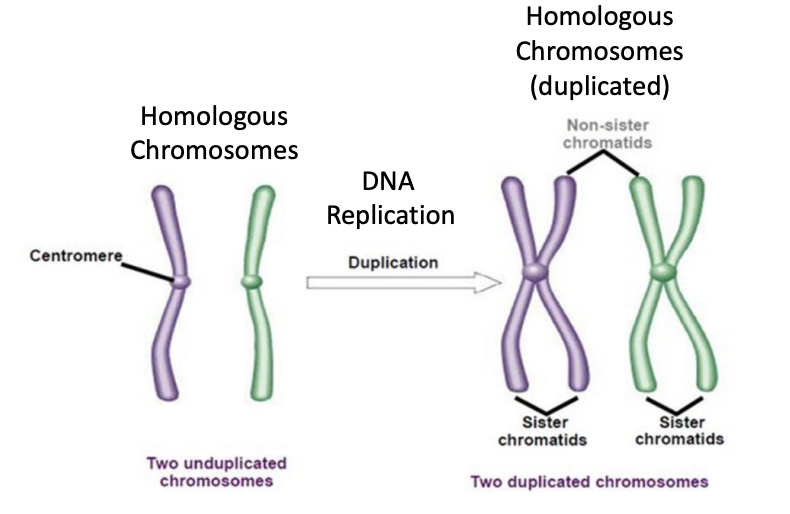
After chromosomes go through DNA replication, there are two identical chromosomes. What is each identical chromosome called and how are they held together?
Each duplicated chromosome consists of two sister chromatids held together by the centromere.
What happens during the G2 phase (second gap) of interphase?
The cell continues growing and duplicated organelles. Additionally, the cell:
Replenishes its energy stores
Synthesizes proteins necessary for chromosome manipulation
Dismantles the cytoskeleton to provide resources for the mitotic spindle
What is the overall purpose of mitosis?
One diploid (2n) parent somatic cell produces two genetically identical diploid daughter somatic cells.
What is the mitotic phase?
A multistep process during which duplicated chromosomes are aligned, separated, and moved to opposite poles of the cell
Then, the cell is divided into two new identical daughter cells
What are the two main portions of the mitotic phase?
Mitosis - Nuclear division, composed of five stages (PPMAT)
Cytokinesis - physical separation of the cytoplasmic components into two daughter cells = produce 2 identical diploid daughter cells (“copy machine”)
What is prophase?
The first stage of mitosis in which:
The nuclear envelope begins to break down
Organelles disperse
Centrosomes move apart to form the mitotic spindle
Sister chromatids condense and become visible
During prophase, what happens to the nuclear envelope, Golgi apparatus, ER, and nucleolus?
The nuclear envelope starts breaking into vesicles
The Golgi apparatus and ER fragment and move to the cell periphery
The nucleolus disappears
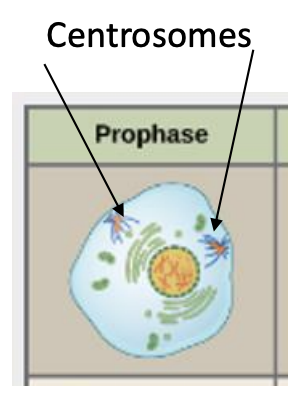
What structure do the two centrosomes give rise to in prophase?
The mitotic spindle, which orchestrates chromosome movement during mitosis
What are centrosomes made of, and what is their role in prophase?
Each centrosome contains a pair of rod-like centrioles at right angles, which help organize cell division
How is the mitotic spindle formed and what is its purpose?
A centrosome, consisting of two centrioles, produce microtubules (fibers) that make the mitotic spindle.
The mitotic spindle attaches to chromosomes to help them move during mitosis.
What happens to the centrosomes and microtubules during prophase?
Centrosomes move to opposite poles of the cell
Microtubules extend between the centrosomes, pushing them farther apart as microtubule fibers lengthen (forms the basis of the mitotic spindle)
What happens to the sister chromatids during prophase?
The sister chromatids coil more tightly and become visible under a light microscope
What is prometaphase?
The stage of mitosis following prophase in which:
The nuclear envelope fully dissolves
The spindle expands
Chromosomes condense further
Kinetochores attach chromatids to spindle fibers
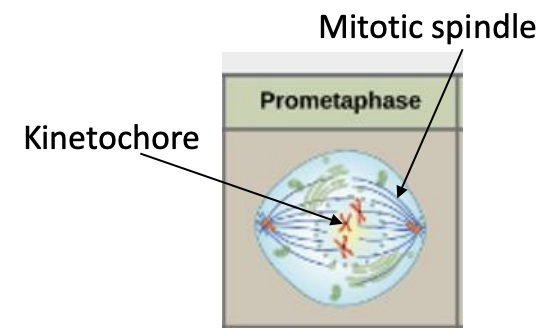
What is the key event happening in Prometaphase in mitosis?
Each sister chromatid attaches to the mitotic spindle microtubules (fibers) between their centromere and a protein complex called a kinetochore.
What happens to the nuclear envelope during prometaphase?
The remnants of the nuclear envelope disappear completely
What happens to the mitotic spindle during prometaphase?
It continues to develop as more microtubules assemble and stretch across the former nuclear area
What happens to chromosomes during prometaphase?
They become more condensed and visually discrete
How do sister chromatids attach to spindle fibers during prometaphase?
Each sister chromatid attaches to spindle microtubules at the centromere via a protein complex called the kinetochore
What is metaphase?
A mitosis stage where chromosomes line up at the cell’s equator (metaphase plate). Homologous chromosomes line up next to each other.
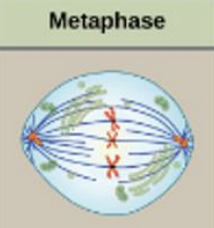
What happens during metaphase?
All of the chromosomes align in a plane called the metaphase plate—the middle of the cell between the two poles
The sister chromatids remain tightly attached to each other
Chromosomes are maximally condensed

What is anaphase?
A mitosis stage where sister chromatids (of duplicated chromosomes) separate (pulled apart) and move toward opposite poles (ends) of the cell.
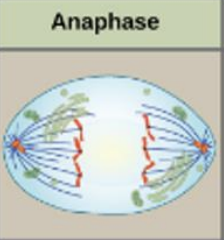
What happens during anaphase?
Sister chromatids (at the metaphase plate) split at the centromere
Each chromatid (now called a chromosome) are pulled toward opposite poles (toward the centrosome where the microtubule was attached)
Cell elongates as the microtubules slide apart at the metaphase plate where they once overlapped

What is telophase?
A mitosis stage where chromosomes decondense (unravel), mitotic spindle is broken down, and two new nuclear envelopes form around each set of chromosomes
*the opposite of prophase
What happens during telophase?
The chromosomes reach the opposite poles and begin to decondense (unravel)
The mitotic spindles are broken down into monomers that will be used to assemble cytoskeleton components for each daughter cell
Nuclear envelopes form around chromosomes.
Opposite of prophase!
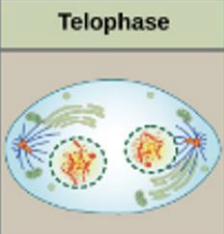
What is cytokinesis?
The second part of the mitotic phase during which cell division is completed by the physical separation of the cytoplasmic components into two daughter cells
When does cytokinesis begin in animal cells?
It begins following the onset of anaphase
How does cytokinesis occur in animal cells?
A contractile ring of actin filaments forms inside the plasma membrane at the former metaphase plate, pulling the equator of the cell inward, forming a fissure
The cleavage furrow deepens (as the actin ring contracts) until the membrane & cell splits into two
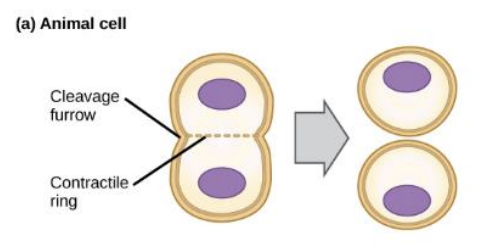
What is the cleavage furrow?
The fissure that forms when the actin ring contracts during cytokinesis, eventually splitting the cell in two (in animal cells)

Review: What are the stages of Mitosis?
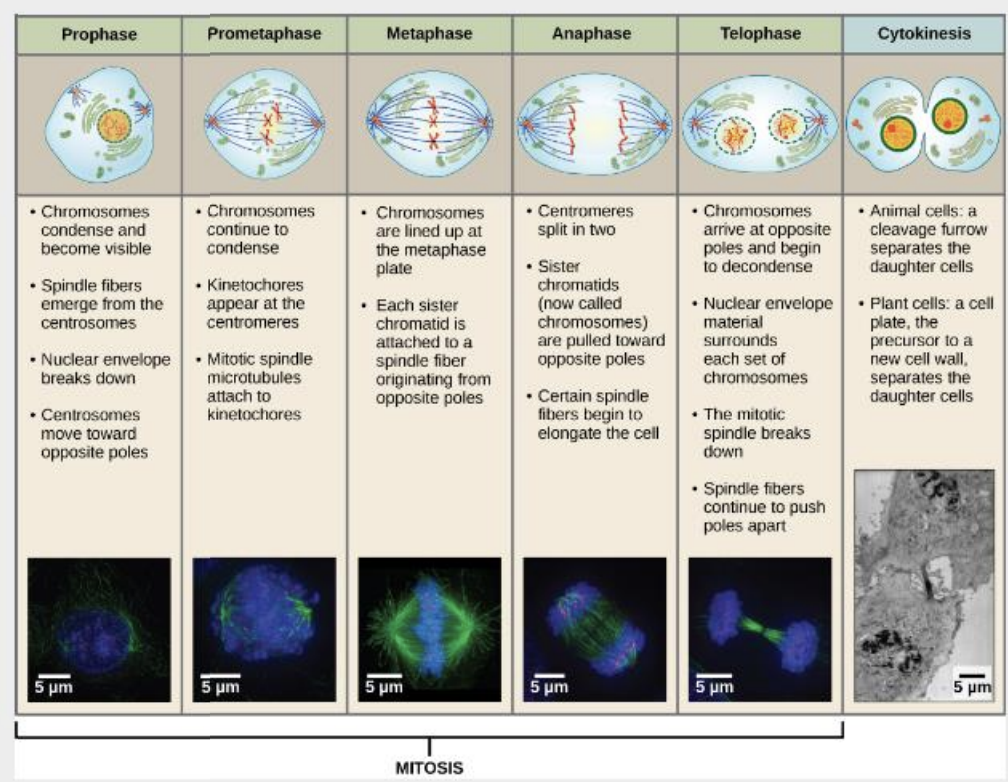
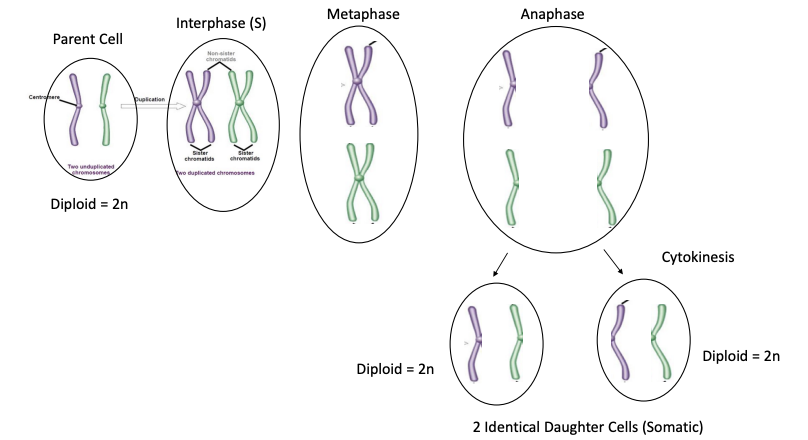
What is the G0 phase?
A quiescent (inactive) stage of the cell cycle where cells are not actively preparing to divide
Having exited the cell cycle
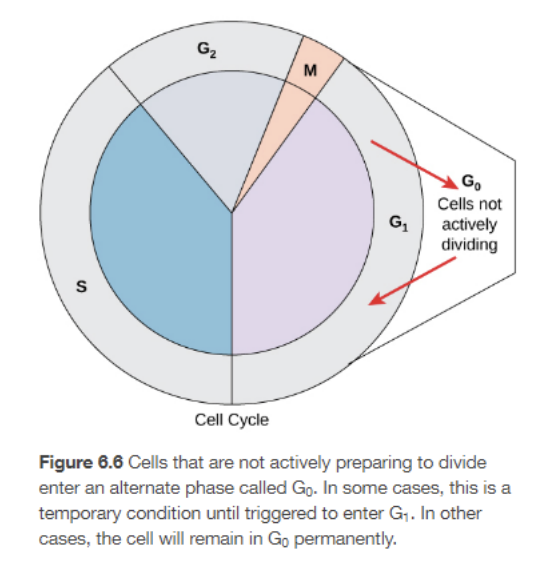
Do all cells adhere to classic cell-cycle pattern?
Not all cells adhere to the classic cell-cycle pattern in which a newly formed daughter cell immediately enters interphase, closely followed by the mitotic phase
Do all cells go through G0?
No, some enter G0 temporarily until external signal triggers re-entry into G1
Other cells that never or rarely divide (like mature cardiac muscle and nerve cells) remain in G0 permanently
Give examples of cells that remain in G0 permanently
Mature cardiac muscle cells
Cortical neurons (nerve cells)
How variable is the length of the cell cycle in humans?
Very variable—ranging from:
A few hours in embryonic development
To 2–5 days for epithelial cells
To an entire lifetime for specialized cells (cortical neurons or cardiac muscle cells) in permanent G0
How variable is the time that a cell spends in each phase of the cell cycle?
There is also variation in the time that a cell spends in each phase of the cell cycle
In rapidly dividing human cells with a 24-hour cell cycle, the G1 phase lasts about 11 hours
What controls the timing of the cell cycle?
Mechanisms that are both internal and external to the cell
What are cell cycle checkpoints?
Surveillance mechanisms that can stop the cell cycle until conditions are favorable, preventing a compromised cell (with mutations) from continuing to divide
What is the purpose of cell cycle checkpoints?
These checkpoints check the cells are various points in the cell cycle to ensure cell size is correct, there is no DNA damage, DNA replication was performed accurately, and chromosomes are attached to the mitotic spindle correctly.
Cells that are damaged are stopped from continuing on in the cell cycle.
When do the three major cell cycle checkpoints occur?
Near the end of G1 (G1 checkpoint)
At the G2—M transition (G2 checkpoint)
During metaphase (M checkpoint)
What is the G1 checkpoint? When does it occur?
First major cell cycle checkpoint that occurs at the end of G1
Determines whether all conditions are favorable for cell division to proceed
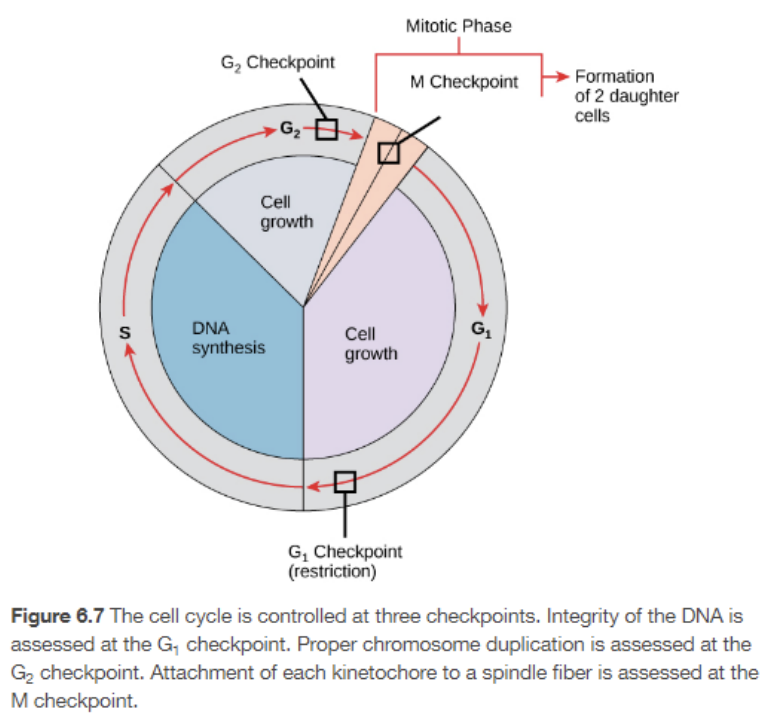
What does the G1 checkpoint check for?
Adequate reserves
Cell size
Damages to the genomic DNA
What happens if a cell does not meet all the G1 checkpoint requirements?
It is not released into the S phase (DNA synthesis)
What is the G2 checkpoint? When does it occur?
Second major cell checkpoint that occurs at the the G2—M transition
Bars the entry to the mitotic phase if certain conditions are not met

What does the G2 checkpoint check for?
Sufficient protein reserves
Proper cell size
Ensures all chromosomes have been replicated
Ensures the replicated DNA is not damaged
What is the M checkpoint? When does it occur?
The M checkpoint is the third major cell cycle checkpoint
Occurs near the end of the metaphase stage of mitosis

What does the M checkpoint (spindle checkpoint) check for?
Determines if all the sister chromatids are correctly attached to the spindle microtubules
Why is the M checkpoint (spindle checkpoint) critical?
The cycle will not proceed until the kinetochores of each pair of sister chromatids are firmly anchored to spindle fibers arising from opposite poles of the cell
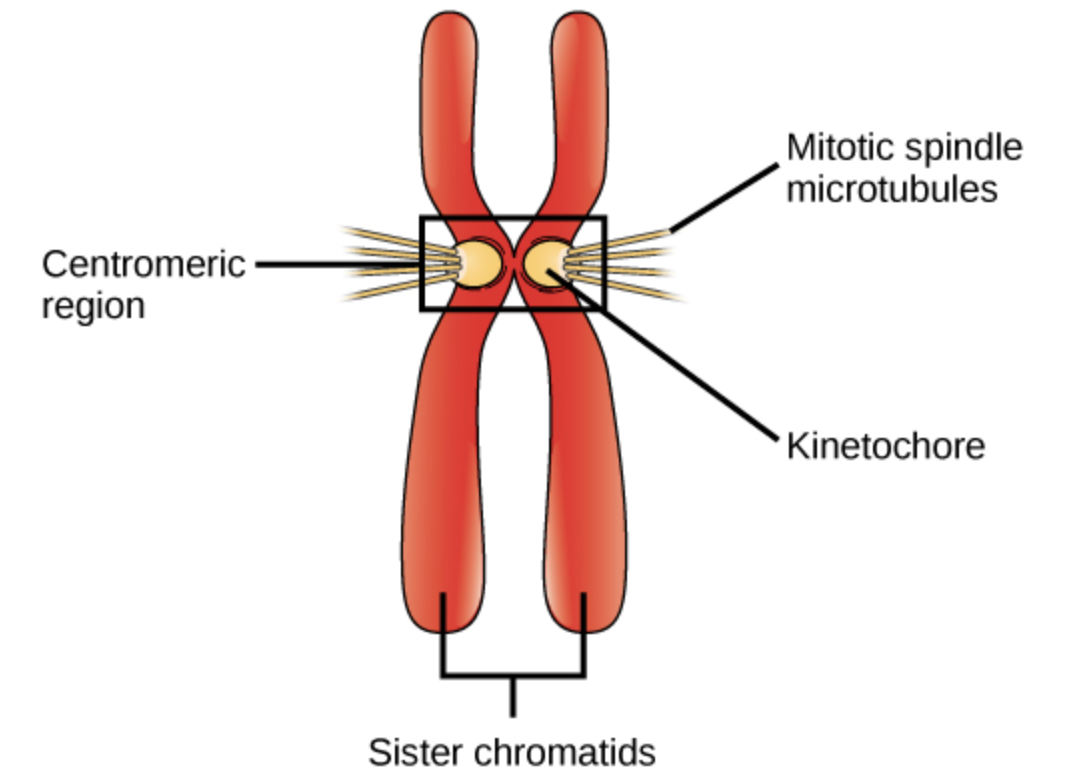
What is cancer?
A collective name for many different diseases caused by a common mechanism: uncontrolled cell division
How does mitosis play a role in cancer?
Cancer is caused by uncontrolled cell division. All cancers begin with a gene mutation that produces a faulty protein that participates in cell division.
Why does cancer occur even though there are many layers of cell-cycle control?
Because errors (mutations) can still occur despite redundancy and overlapping control systems
Even when all of the cell-cycle controls are fully functional, a small percentage of replication errors (mutations) will be passed on to the daughter cells
How do all cancers begin?
When a gene mutation gives rise to a faulty protein that participates in the process of cell reproduction
How do small, uncorrected errors lead to cancer?
Errors accumulate over generations of cells (passed down from parent cell to daughter cells), producing more non-functional proteins from damaged DNA
What happens as more uncorrected errors build up in cells?
The pace of the cell cycle speeds up while the effectiveness of control and repair mechanisms decreases, leading to less regulation of cell growth
How do tumors form in cancer?
Mutated cells grow uncontrollably, outpacing the growth of normal cells in the area
This results in a tumor, which is an abnormal mass of cells
What are proto-oncogenes?
Normal genes that code for normal growth-stimulating proteins (helps promote cell division)
